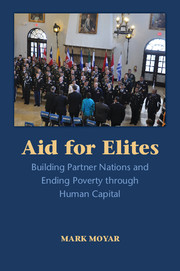Book contents
- Frontmatter
- Contents
- Preface
- Acknowledgments
- 1 Pathways to Development
- 2 How Governments Work
- 3 Civilization
- 4 Human Capital Development
- 5 Human Capital and National Security
- 6 Training
- 7 Militarization
- 8 Education in the Third World
- 9 Education in the United States
- 10 Support
- 11 Measurement
- 12 Conclusion: A New Foreign Assistance Strategy
- Notes
- Index
- Frontmatter
- Contents
- Preface
- Acknowledgments
- 1 Pathways to Development
- 2 How Governments Work
- 3 Civilization
- 4 Human Capital Development
- 5 Human Capital and National Security
- 6 Training
- 7 Militarization
- 8 Education in the Third World
- 9 Education in the United States
- 10 Support
- 11 Measurement
- 12 Conclusion: A New Foreign Assistance Strategy
- Notes
- Index
Summary
This chapter, and the five that come after it, examine the principal methods by which the United States and the rest of the first world can help the governments of poor countries develop their human capital. They explore and evaluate what has been tried, both in recent years and decades long gone by, and consider new solutions for new problems. Based on those evaluations and consideration of current world conditions, they make recommendations for the way ahead.
We begin with training, in all its forms. Training may include instruction in a classroom, a government office, or a forest. An instructor may train a group of one hundred or ten. In some cases, the instructor works with a single individual, a practice that is variously called training, advising, or mentoring. Generally speaking, training confers specific technical competencies, in contrast to education, which confers information and ideas for the general betterment of the mind.
When it comes to public sector employees, the line between training and education is often blurred. Some facts or concepts contribute to both technical proficiency and general intellectual heft. Some institutions provide a mixture of training and education, particularly institutions dedicated exclusively to employees of the state. Institutions and programs that are more concerned with training than with education are covered in this chapter; the others are addressed in the next chapter.
U.S. TRAINING: AN OVERVIEW
During the first half of the twentieth century, the United States conducted training of foreign personnel in its one major colony – the Philippines – and in Central American and Caribbean countries where it fought the various “banana wars.” Its training efforts were small and rudimentary in comparison with what European colonialists had been providing for centuries. The United States did not become a large purveyor of overseas training until the Cold War, when the imperative of containing Communism drove it to seek allies and influence across the third world.
During the 1950s, American training of foreign governmental personnel mushroomed into a massive enterprise, larger than anything ever attempted by any other nation or empire. It has retained its size in ensuing decades, although its shape has changed markedly. Yet the American people know next to nothing about it. Familiarizing Americans with the foreign training that they fund is therefore a major objective of this chapter.
- Type
- Chapter
- Information
- Aid for ElitesBuilding Partner Nations and Ending Poverty through Human Capital, pp. 97 - 113Publisher: Cambridge University PressPrint publication year: 2016

